Author: Insight VC
Compiled by: TechFlow
With a market capitalization of approximately $63 billion, Solana is one of the leading blockchain platforms. It has become a top choice for onboarding off-chain users, particularly in areas such as decentralized physical infrastructure networks (DePINs), mobile applications, and payments. In previous newsletters, we highlighted DePINs built on Solana, including Helium and Hivemapper .
Solana has made significant progress over the past year, especially as its native token has seen a surge after Visa announced plans to expand its stablecoin capabilities on the Solana blockchain. At the 2024 Consensus conference, PayPal Holdings, Inc. (NASDAQ: PYPL) revealed that PayPal USD (PYUSD) is now available on Solana, making PayPal’s stablecoin faster and more economical to use (currently, PYUSD has a market cap of $827.83 million, with 58.3% on Solana and 41.7% on Ethereum).
Core Team:
Founder and CEO: Anatoly Yakovenko
Co-founder: Raj Gokal
Co-founder and CTO: Greg Fitzgerald
Co-founder: Stephen Akridge
Co-founder and Chief Scientist: Eric Williams
Solana Funding Insights - Total Funding: $359 million
Financing rounds:
Seed Round : Date: Q1 2018 | Amount raised: $3.17 million | Price: $0.04
Private round: Date: Q2 2018 | Amount raised: $12.63 million | Price: $0.2
Selected Investors: Jump Crypto, BlockTower Capital, Distributed Global, Reciprocal Ventures, and others.
Series A: Date: Q2 2019 | Amount raised: $20 million
Selected Investors: Multicoin Capital (lead), Distributed Global, Slow Ventures, RockawayX, NGC Ventures, Blockchange Ventures, etc.
Validator Round: Date: Q3 2019 | Amount raised: $5.7M | Price: $0.225
Private Sale and Pre-Sale: Date: January 2, 2020 | Amount Raised: $2.29 million | Price: $0.250
Strategic Round: Date: Q1 2020 | Amount raised: $2.29 million | Price: $0.25
ICO: Date: March 23, 2020 | Amount raised: $1.76 million | Price: $0.220 | Platform: Coinlist
Token Generation Event ( TGE ) and Distribution: Date: April 10, 2020 | Listing Price: $0.67
Undisclosed round: Date: June 9, 2021 | Amount raised: $314 million
Selected investors: Andreessen Horowitz (a16z) (lead investor) , Polychain Capital (lead investor) , Multicoin Capital, CMS Holdings, Ryze Labs (BOC Global Capital), Alameda Research, Jump Trading, etc.
Solana (SOL) Token Economics (September 12, 2024)
Total SOL Supply : 584,294,896 SOL
Circulation: 467,932,073 SOL (80.1%)
Non-circulating amount: 116,362,823 SOL (19.9%)
Market Cap: $63.3 billion (5th overall, 3.104% of total crypto market ($2.04 trillion))
Total Staked Supply : 383,399,756.5 SOL (65.6% of Total Supply)
Locked staked SOL: 48,163,740.1 SOL (12.6% of total staked)
Inflation : The current interest rate is 5.036%, which is reduced by 15% per year for inflation, resulting in a final interest rate of 1.5%
Supply Dynamics: Staked SOL includes both active and unstaked assets; locked assets are temporarily frozen until a specific date and are typically part of investments or grants from the Solana Foundation and Solana Labs.
Transaction fee structure: 50% of transaction fees are destroyed, and the rest is distributed to validators as block rewards.
Solana’s Inflation Mechanism
Token Issuance and ReductionSolana 's SOL token is introduced through two main mechanisms: Genesis Block Block and protocol inflation (staking rewards mechanism). On the other hand, SOL tokens are mainly removed from circulation through the destruction of transaction fees. The inflation schedule is controlled by three parameters: the initial inflation rate is 8%, the disinflation rate is -15%, and the long-term inflation rate is 1.5%. The current inflation rate is 5.07%, and Solana's inflation began at the 150th period in February 2021.
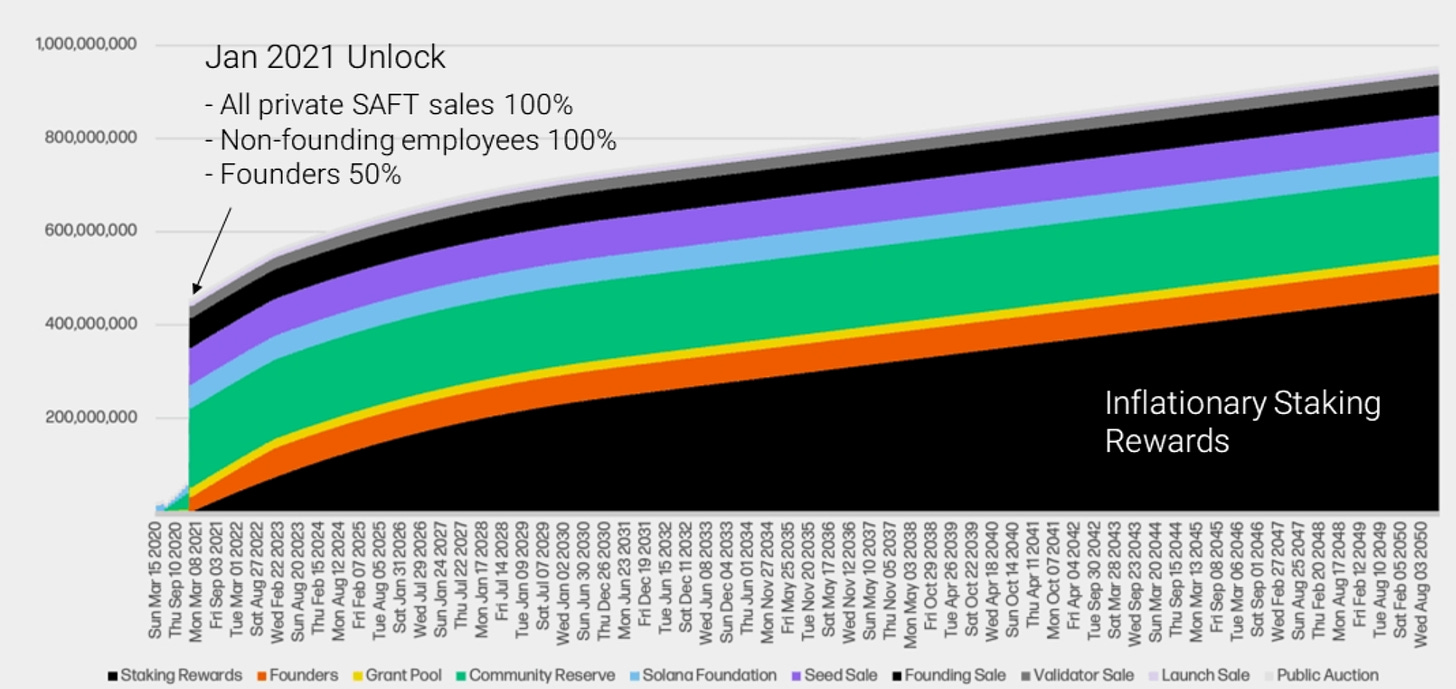
SOL unlock schedule ( helius )
Analysis of the impact on network participants
Proof of Stake (PoS) inflation transfers wealth from non-stakers to stakers, diluting the value of non-stakers’ holdings while rewarding users who participate in staking. Solana maintains a high staking rate of 65%, which is a strong performance compared to other networks. As of now, approximately 380 million SOL has been staked, and significant liquidity changes have been observed between periods.
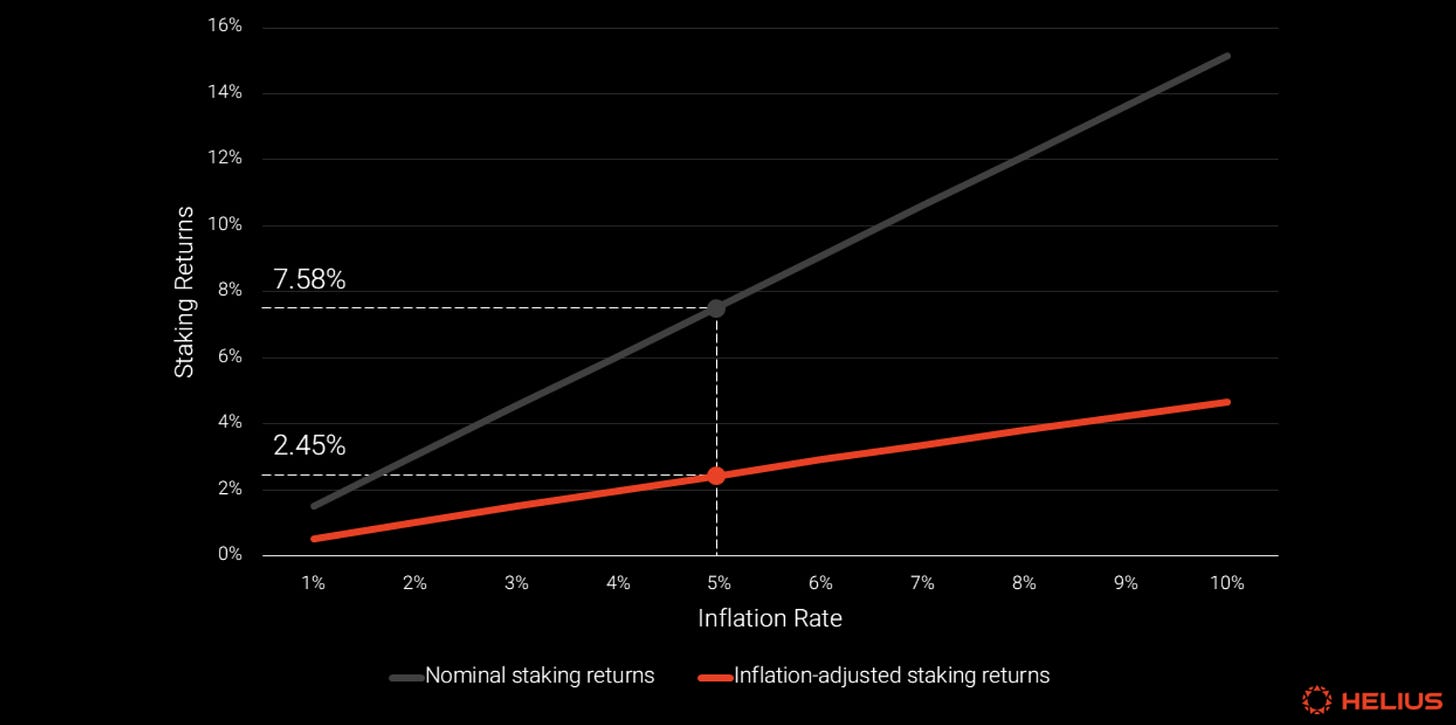
The relationship between staking rewards and inflation rate
Calculation method of staking income
The staking income is affected by the inflation rate, the validator's online time, the commission rate charged by the validator, and the percentage of SOL staked. The formula is:

Fee destruction and inflation factors:
The burning of transaction fees, penalty mechanisms, and other user-related losses contribute to disinflationary pressure, but the impact is limited. Fee burns as a percentage of staking rewards peaked at 7.8% in March 2024, but have recently averaged 3.2%. After SIMD-96 is implemented, the impact of these burns will become negligible. Penalties, while possible, occur less frequently and are not currently a significant disinflationary factor.
Tax and market impact:
In many jurisdictions, receiving inflation rewards may be considered a taxable event, which could lead to selling pressure from stakers due to the need to pay taxes. In addition, Proof of Stake (PoS) inflation may exert sustained downward pressure on the price of SOL, affecting fair price comparisons and network economics.
Dependency of validator income on inflation :
Validators have traditionally relied on inflationary commissions, but recent growth in alternative revenue streams, such as Maximum Extractable Value (MEV) and block rewards, provide new sustainable avenues for revenue. The long-term sustainability of these alternative revenue streams is uncertain.
Inflation parameters and scenarios (Source: Helius )
Solana’s inflation is currently set by an 8% initial inflation rate, a -15% deflation rate, and a 1.5% long-term inflation rate. As of September 2024, the current inflation rate is approximately 5%, and the current total supply is 584 million SOL. Four scenarios are proposed to explore possible changes:
Scenario A: Doubling the inflation rate from -15% to -30%.
Scenario B: Halving the long-term inflation rate from 1.5% to 0.75%.
Scenario C: Immediately halve the current inflation rate, from 5% to 2.5%.
Scenario D: Halve the current inflation rate, double the disinflation rate, and halve the long-term inflation rate.
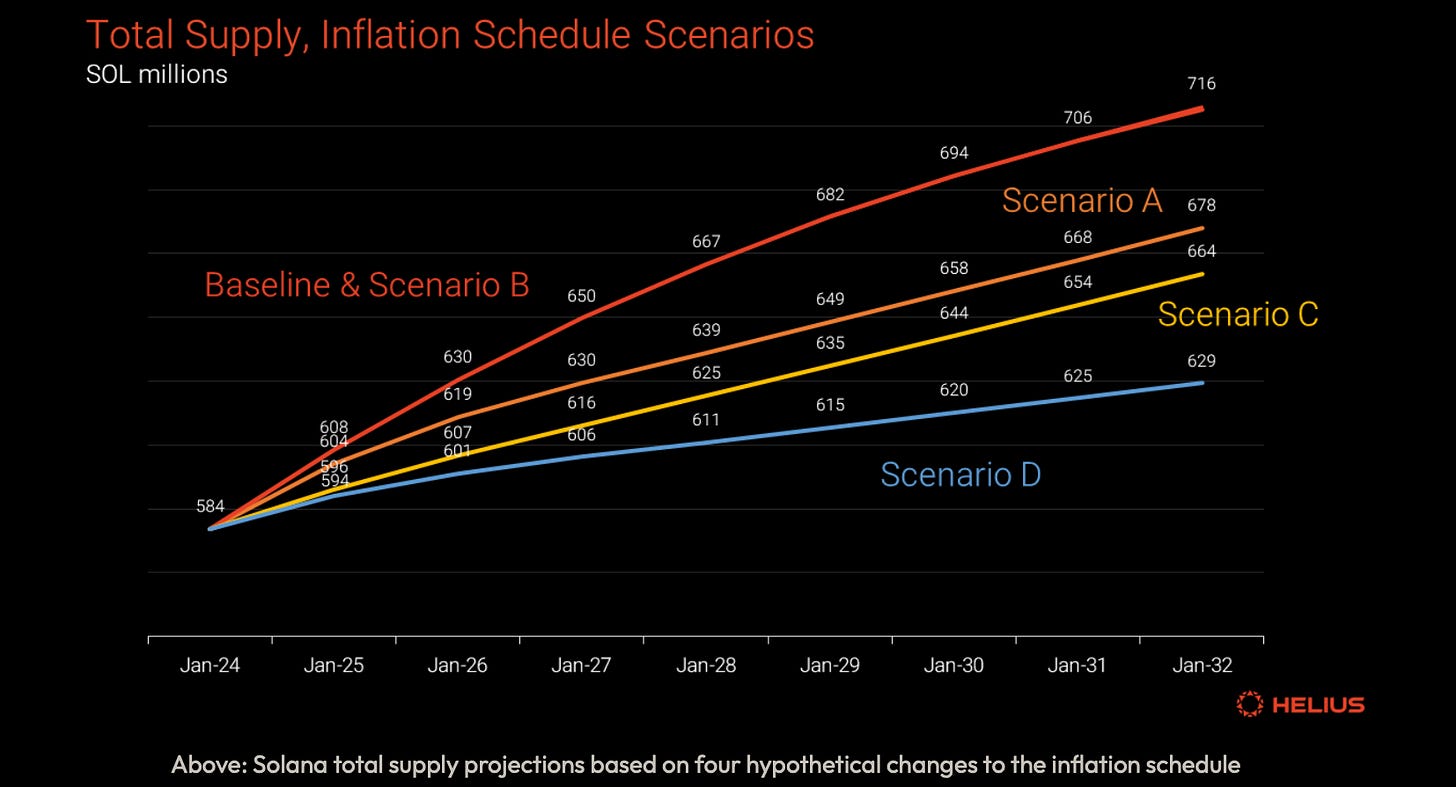
Impact on supply and price:
Over the next eight years:
Scenario A: Reduce total supply by 5.3% (to 678 million SOL).
Scenario B: The impact is minimal, only reducing 1 million SOL.
Scenario C: Reduce total supply by 7.3% (to 664 million SOL).
Scenario D: Reduce total supply by 12.2% (to 629 million SOL).
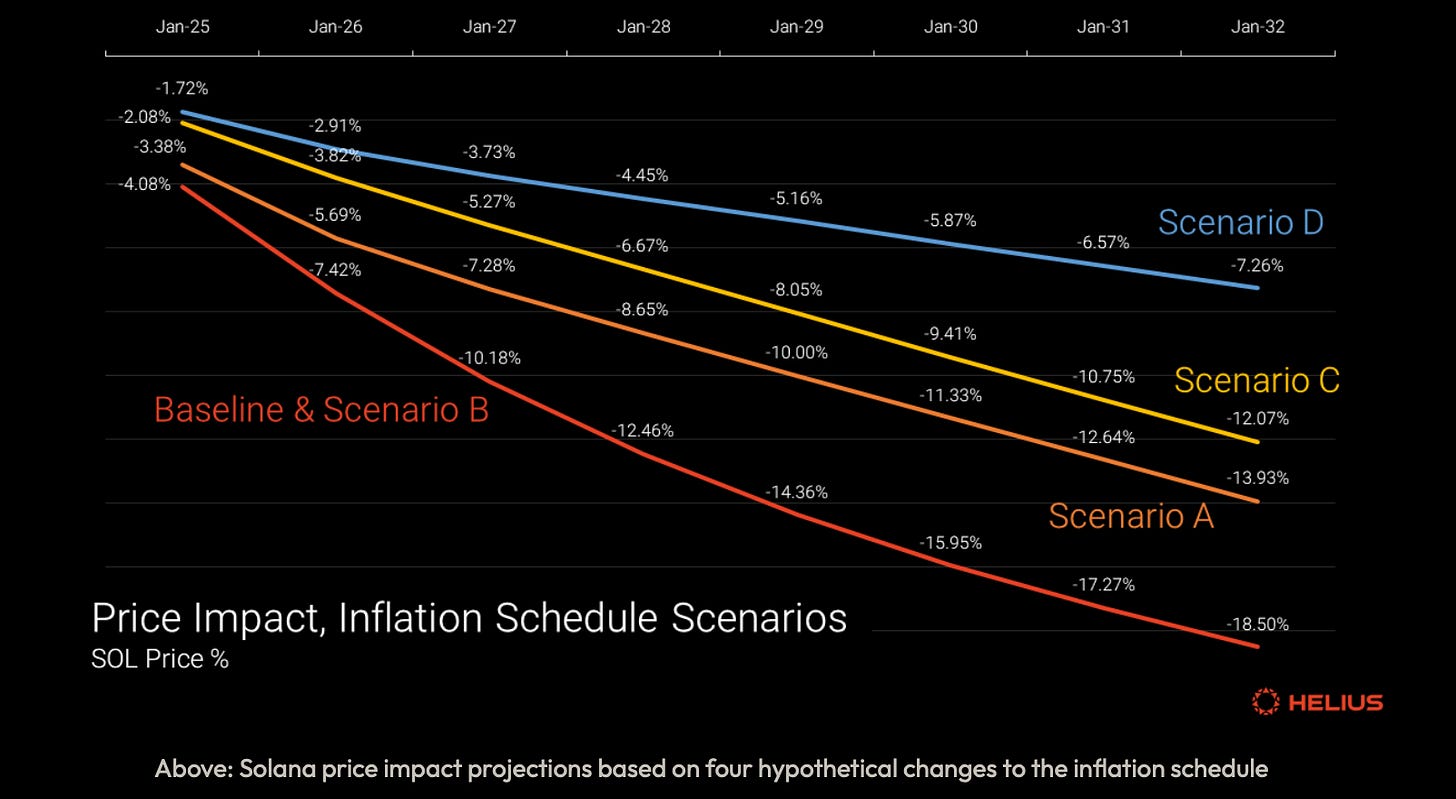
Assume the initial price of SOL is $150, and keep other variables constant:
Baseline: The current inflation plan reduces the price by 18.5%, to $122.25.
Scenario A: Reduce the price by 13.93% to $129.10.
Scenario C: Reduce the price by 12.07% to $131.90.
Scenario D: Reduce the price by 7.26% to $139.10.
Architecture and Design
Solana is a high-performance blockchain designed for speed, efficiency, and scalability. It supports thousands of transactions per second with low latency and extremely low transaction fees, with a block time of 400 milliseconds and fees of just a fraction of a cent. This report will explore Solana's mechanics and system architecture, emphasizing its ability to scale and interact seamlessly in a unified ecosystem.
programming language
Solana mainly uses Rust for smart contract development because of its concurrency, memory safety, and control over underlying resources, ensuring the security and predictability of the code. Although Rust is the main language, Solana also supports all LLVM-compatible languages, such as C and C++, to attract more developers to participate. For client development, Solana provides SDKs for Java, C#, Python, Go, and Kotlin to facilitate communication with the Solana network through the JSON RPC API. This diverse language support improves developer accessibility and flexibility.
Mechanism and system architecture
Solana's architecture uses a unified and composable ecosystem that integrates all applications on the same blockchain. This design avoids the need for bridges, independent chain IDs, or liquidity fragmentation, thereby improving the user experience and simplifying the interaction between applications. The performance of the blockchain is based on its characteristics of fully utilizing hardware capabilities, ensuring that the software can scale with hardware advances.
Solana's transaction process begins with users submitting transactions to blockchain leaders, who package them into blocks and propagate them to the network for execution and confirmation by other validators. Changes to the core protocol are managed through Solana Improvement Documents (SIMD), which are reviewed and voted on by the community.
Transaction Lifecycle
Solana transactions are the only way to change the state of the blockchain. Each transaction, or "transaction message," consists of a header, account addresses, the most recent block hash, and instructions. Transactions are atomic, ensuring that all operations in a transaction either succeed or fail. The structure facilitates conflict-free parallel processing of transactions by requiring accounts to be listed in advance for predefined optimizations.
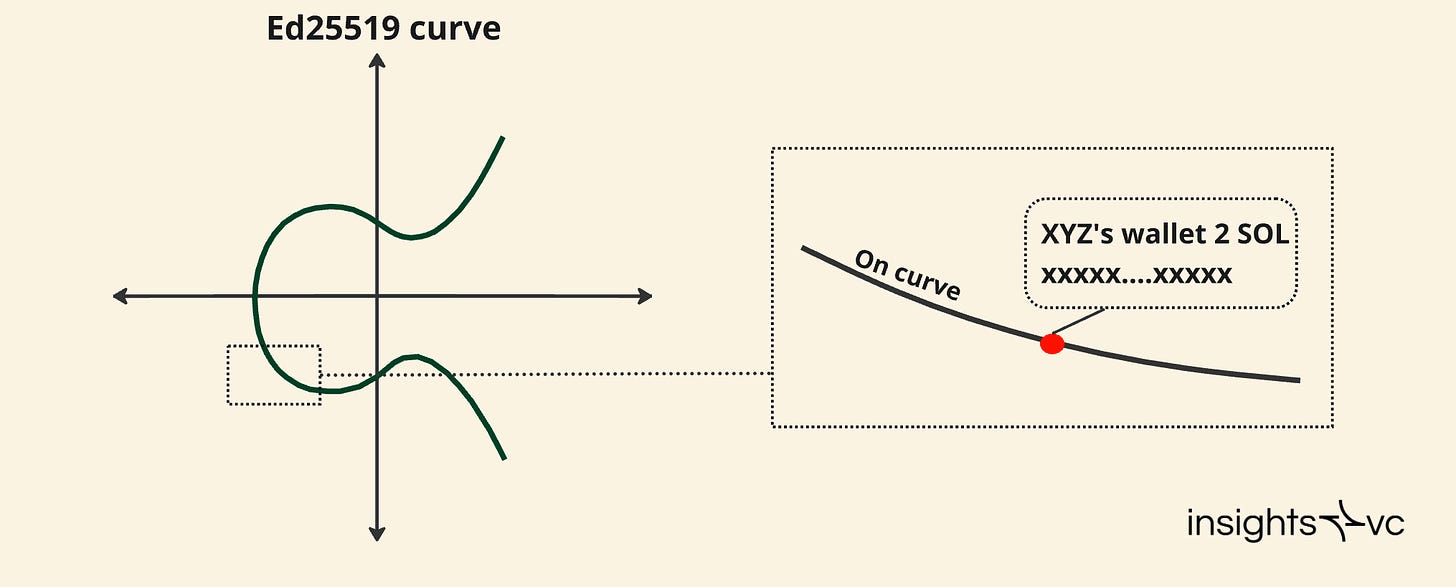
Security and key management
Solana uses Ed25519 elliptic curve cryptography to generate public-private key pairs, ensuring high security and efficient transaction signing. The wallet generates a key pair, the public key is used as an account identifier on the blockchain, and the private key is used for authorization. Transactions are signed with the private key to ensure the integrity and authenticity of the data, and then verified with the public key.
Network Operations
Solana uses a leader-driven approach without a memory pool, designating specific validators as leaders to process transactions within a fixed period of time (400 milliseconds). Validators are selected based on their stake and rotate roles according to a predetermined schedule to enhance the decentralization and security of the system.
The network uses Stake-Weighted Quality of Service (SWQoS) to prioritize transactions from staked validators and reduce the impact of malicious transactions and Sybil attacks. SWQoS reserves 80% of the leader’s processing power for transactions processed by staked validators, and the rest is allocated to non-staked nodes.
Improved scalability
Recent scaling solutions, such as SVM rollups and ZK compression, are being developed to further enhance Solana’s performance, although they are still in the early stages. The blockchain uses the QUIC network protocol, which facilitates efficient, secure, and scalable transaction message transmission to cope with high throughput requirements.
Consensus and Block Production
Solana's consensus mechanism uses continuous block construction, and leaders build and broadcast blocks in real time during their time slots. This approach reduces latency and optimizes transaction processing. The validator's Transaction Processing Unit (TPU) manages block creation and executes transactions in parallel as much as possible to maximize throughput and efficiency.
Proof of History (PoH)
For a detailed description of the history proof mechanism, please refer to the Solana white paper .
Proof of History (PoH) is a key feature of Solana that acts as a cryptographic clock that synchronizes the network by establishing a verifiable order of events. Unlike the Proof of Work consensus algorithm, PoH is not used to reach consensus, but rather to provide a time reference that validators use to order transactions and follow the leader's schedule.
PoH works by continually computing a chain of SHA-256 hashes, with each hash dependent on the previous one. This sequence must be computed in order, thus creating a "micro proof of work". Validators run PoH services to generate these hashes, which are difficult to generate but easy for other validators to verify. By embedding transaction data in the hash chain, PoH timestamps transactions, proves the order in which transactions occurred, and prevents validators from manipulating the order of blocks.
Mechanism and function
Each Solana validator continuously runs a PoH service, hashing in sequence to maintain a cryptographically timestamped ledger. When the current leader processes new transactions, they are combined with the current PoH hash, updating the chain and embedding the transaction into the cryptographic timeline. This process ensures that the leader cannot manipulate the timing and order of transactions.
Within each 400 millisecond block, the PoH stream includes approximately 800,000 hashes and time stamps marking the passage of time, each time stamp is spaced 6.25 milliseconds apart. These time stamps serve as proof of activity and maintain the rhythm of network operations. Even when not serving as a leader, validators still keep the PoH clock running in order to synchronize with the rest of the network and ensure that the leader's schedule is followed.
Account Model
Solana's state management relies on an account database, AccountsDB, which is a large key-value store where the key is the account address and the value is the corresponding data. There are multiple types of Solana accounts:
User account: represents the user who owns the private key.
Data accounts: store status information, such as token balances.
Program account : Contains the executable code for a specific program.
Native program account: executes the core functions of the network.
Solana distinguishes code from state by keeping program accounts immutable, while storing state in separate accounts. This separation enables efficient state management and unique optimizations for the Solana architecture.
Program and status management
Programs on Solana are written in languages like Rust to manipulate data in accounts, but they do not store state internally. Instead, programs interact with Program Derived Addresses (PDAs), which are special accounts that do not have private keys and are controlled by the program. PDAs ensure that only the relevant program can modify the state, thereby enhancing security and control over state changes.
Leasing and Account Management
To address state bloat, Solana implements a leasing mechanism that requires accounts to maintain a minimum SOL balance. When an account is no longer needed, it can be closed and the lease balance returned to the user. This approach encourages efficient use of account state and prevents unnecessary accounts from remaining open indefinitely.
Turbine: Data Propagation
Turbine is Solana’s data dissemination protocol, inspired by BitTorrent. It splits transaction data into small packets called “shards”, which are then propagated across the network in a structured manner. Fragments are grouped into batches and broadcast through a Turbine tree, with validators organized in layers to forward fragments to other validators. This reduces the data load on leaders and improves the network’s ability to distribute blocks efficiently.
Consensus: Tower BFT
Solana uses Tower BFT, a custom Practical Byzantine Fault Tolerance (PBFT) implementation enhanced by PoH’s synchronized clocks. This approach reduces communication overhead at consensus time because validators rely on a predetermined transaction order provided by PoH rather than multiple rounds of messaging. Validators vote on blocks using credit earned for correct voting, and the system ensures that validators remain on the chosen fork for a minimum duration, reducing the likelihood of forks.
Gossip and Archiving
Solana's Gossip network acts as a control plane, disseminating key metadata to ensure that nodes in the network can communicate and synchronize their states. Archive nodes save the history of the network, and data is stored in warehouse nodes to ensure the availability of past transactions.
Economics and Jito
Solana's economic model includes an inflation-based staking rewards mechanism, where validators earn SOL by participating in consensus and producing blocks. Block rewards include transaction fees, part of which is destroyed and part of which is rewarded to validators who produce blocks. Liquid staking enables SOL holders to stake in a pool, obtain Liquid Staking Tokens (LSTs) that can be traded or used in applications, and earn staking rewards at the same time.
Jito clients are widely adopted by Solana validators, and they enhance economic incentives by implementing an out-of-protocol block space auction system that allows transactions to be prioritized over standard transaction fees through tips. This significantly increases validator rewards and drives widespread adoption of Jito clients on the Solana network.
Solana Virtual Machine (SVM)
The Solana Virtual Machine (SVM) is an innovative framework designed to manage Maximum Extractable Value (MEV) in the Solana blockchain. MEV involves extracting additional value by reordering, including, or excluding transactions. SVM provides technology and protocols to detect, analyze, and manage MEV activity, improving the efficiency, fairness, and security of the Solana ecosystem.

Ethereum Virtual Machine (EVM) and Solana Virtual Machine (SVM)
SVM differs from the Ethereum Virtual Machine (EVM) in terms of smart contract execution and transaction processing. In SVM, each validator executes smart contracts individually, resulting in high transaction throughput. In contrast, EVM requires nodes to reach consensus for execution, which makes processing slower. In addition, Solana's parallel processing model allows multiple transactions to be executed simultaneously, while Ethereum's sequential model processes one transaction at a time, making Solana faster and more efficient.
Purpose and Importance of SVM
SVM aims to solve the Maximum Extractable Value (MEV) problem by providing a structured approach to avoid manipulation in transaction ordering and block validation. This is critical to maintaining the integrity of financial interactions on Solana, protecting users from front-running and other practices, and enhancing the credibility of the network. Given Solana's high transaction throughput, effective MEV management is critical to preventing rapid value extraction, which could harm the interests of ordinary users.
Defining the Solana VM
The definition of the SVM varies within the Solana ecosystem. Some view it as comprising the full transaction processing pipeline, including the validator runtime and program execution, while others emphasize the low-level eBPF virtual machine responsible for executing programs. Typically, the SVM is viewed as a comprehensive system involving the Bank component of the Agave validator, which is responsible for managing state in each time slot. The SVM processes transactions in batches, with each batch containing instructions for a specific program and utilizing a caching mechanism to optimize execution efficiency.
Opportunities for SVM
The decoupling and well-defined interface of the SVM enables it to have multiple applications beyond Solana validators, including:
Off-chain services: Simulate Solana’s transaction processing off-chain for simulation and testing.
Lite Clients: Enable fraud proofs for lightweight clients, improving scalability and security.
State Channel: Manages SVM-based peer-to-peer connections and publishes the final results to the main chain.
Rollups: Serves as an execution layer for Rollups to enhance scalability without the added overhead of a full consensus protocol.
Avalanche Subnet: Integrates with the Avalanche module for consensus and network connectivity.
Extended SVM: SVM units customized for specific protocols for enhanced flexibility. SVM is now available through the solana-svm Rust crate, supporting a variety of applications and driving innovation in the Solana ecosystem.
FTX
However, Solana encountered challenges after the collapse of FTX, a major player closely associated with its ecosystem. FTX founder Sam Bankman-Fried (SBF) was a major supporter of Solana, driving the launch of projects traditionally associated with the Ethereum ecosystem, such as Serum DEX. Under SBF's influence, FTX grew into one of the largest centralized exchanges, further increasing Solana's popularity. Unfortunately, FTX's misuse of company assets and customer deposits for high-risk investments led to its collapse, putting the Solana ecosystem associated with FTX at significant risk. On September 12 , FTX/Alameda Research unstaked $24 million worth of $SOL, and Solscan data showed that the wallet still held more than $1 billion in $SOL, including staked and locked tokens. Despite these challenges, there is a core developer community that is aligned with Solana's philosophy and remains committed. Solana responded by focusing on enhancing the stability of the network and creating a more developer-friendly environment, solving technical issues to rebuild the community's trust.
A curated list of projects based on the Solana blockchain
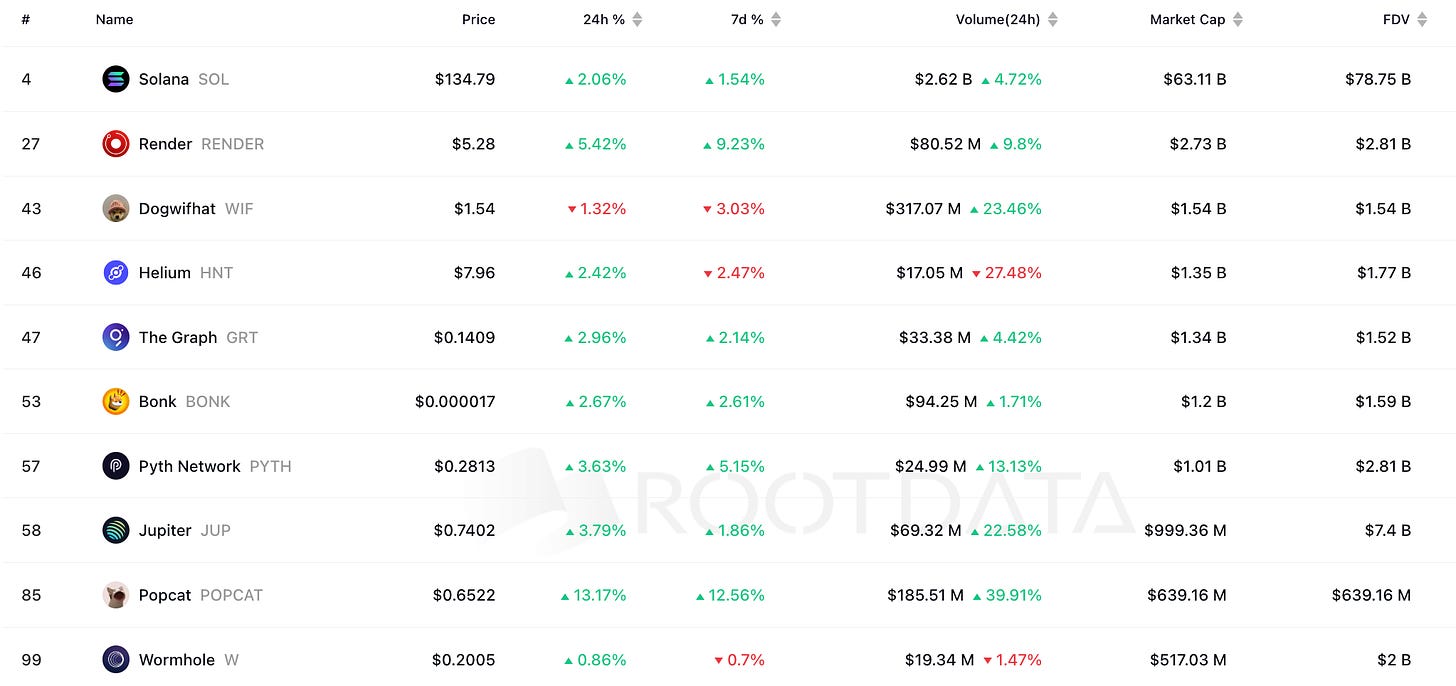
Solana Ecosystem (List of Top 10 Projects by Market Capitalization)
Neon EVM: The Neon EVM enables Ethereum-based applications to run on Solana, providing faster processing speeds, lower costs, and leveraging Solana’s parallel processing capabilities.
Eclipse: A second-layer solution for Ethereum that leverages Solana’s SVM, uses Ethereum for settlement, and employs zero-knowledge proofs for security.
Nitro: A solution that bridges Solana with the Cosmos and IBC ecosystems, enhancing interoperability and access to liquidity.
Wormhole : A cross-chain bridge that supports seamless asset and information transfer between multiple blockchains, including Solana.
Allbridge: A cross-chain bridge that facilitates asset transfers between Solana and other blockchains, enhancing Solana’s interoperability.
LI.FI: A liquidity aggregation protocol that integrates multiple bridge solutions and decentralized exchange (DEX) aggregators to enable cross-network exchanges.
DePIN
Helium : A decentralized wireless network that leverages Solana for scalability, supports Internet of Things (IoT) devices, and provides affordable connectivity solutions.
Hivemapper : A decentralized mapping network that rewards users with tokens by contributing real-time road images using dashcams.
Render Network & io.net : A distributed GPU computing network based on Solana for 3D rendering and AI tasks, providing scalable and efficient computing power.
IoTeX: A Web3 infrastructure platform that connects smart devices and real-world data to the blockchain, improving data accuracy and practical value.
Teleport: A decentralized ride-sharing service based on Solana that provides drivers with lower fees and higher income through blockchain protocols.
DeFi
Marinade Finance: A liquid staking platform based on Solana that allows users to earn staking rewards through mSOL tokens while maintaining liquidity.
Jito: A protocol to increase MEV profits through liquid staking, aiming to enable permissionless operations in the Solana ecosystem.
Sanctum: A liquidity sharing solution designed for liquid staking tokens on Solana, enabling seamless interaction and yield generation.
Drift Protocol: A decentralized trading platform that provides spot and perpetual contract trading based on Solana and provides real-time price updates.
Jupiter: Solana’s primary decentralized exchange (DEX) aggregator, providing efficient trade routing, limit orders, and perpetual contract trading.
Zeta Markets: A decentralized derivatives trading protocol that supports options and futures trading.
marginfi: A decentralized lending protocol that provides comprehensive financial services across multiple DeFi protocols.
Kamino: A DeFi platform that supports strategic financial activities including lending, liquidity provision, and asset management.
Parcl: Decentralized real estate investment platform that tracks property prices using data feeds.
Others (NFT & Memecoins etc.)
Magic Eden: The main NFT marketplace on Solana, supporting multiple chains and providing a user-friendly interface and low fees.
Tensor: A marketplace built specifically for professional NFT traders, integrating AMM and real-time data features.
Metaplex: A platform that provides tools for creating, selling, and managing digital assets, designed specifically for Solana.
DRiP: An NFT offering platform supporting new artists, providing affordable minting and free minting of NFT art.
TipLink: A lightweight wallet that enables easy asset transfers via link or QR code, accessible via Gmail and Solana accounts.
Solchat: A Solana-based communication protocol for on-chain messaging and P2P calls, expected to be integrated with the Solana mobile ecosystem.
Dialect: A decentralized messaging protocol that allows tokens to be passed via messaging.
Mad Lads: An xNFT collection created by Coral to explore NFTs as decentralized applications and revitalize the Solana community.
MonkeDAO: The first NFT DAO on Solana, originated from Solana Monkey Business and participated in multiple community-led initiatives.
Superteam DAO: A DAO dedicated to promoting Solana and supporting innovative projects through a community-driven approach.
Solana University: An international student organization providing educational events and resources about Solana and Web3.
Memecoins: $BONK; $WIF, $POPCAT
Key indicators (September 12, 2024)
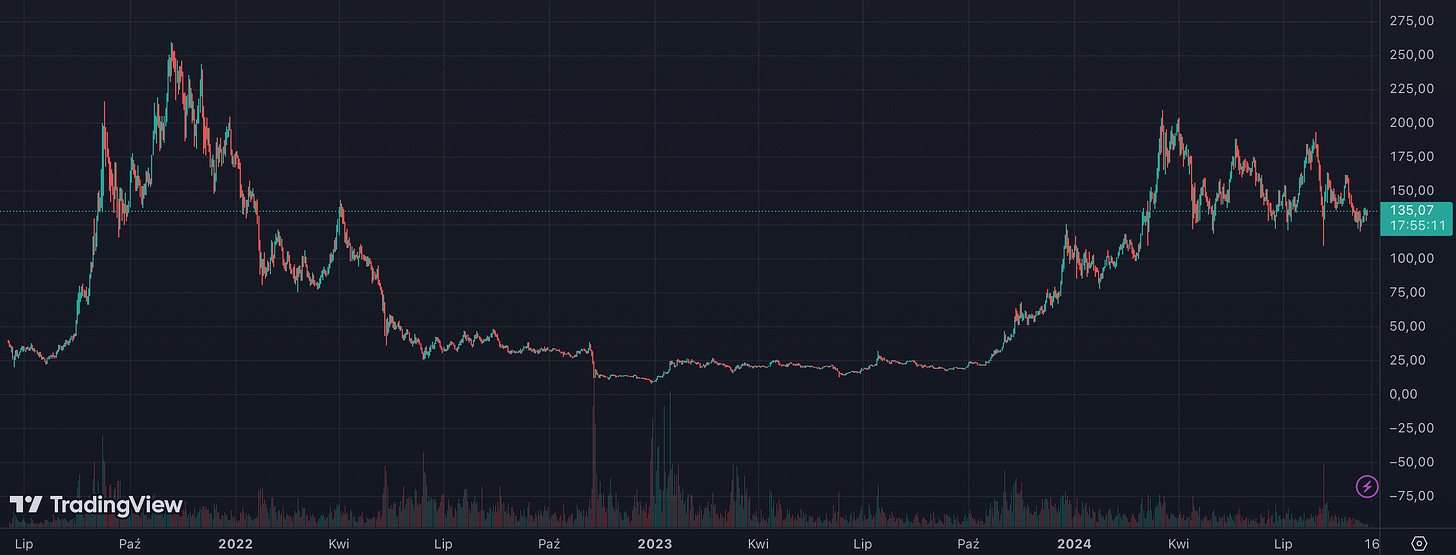
SOL/USD - $135.07 (UTC 06:06; September 12, 2024); market capitalization is $63.3 billion.

SOL market (top 5 by 24-hour trading volume; September 12); data source: coingecko

Total locked value – $80.45 billion.
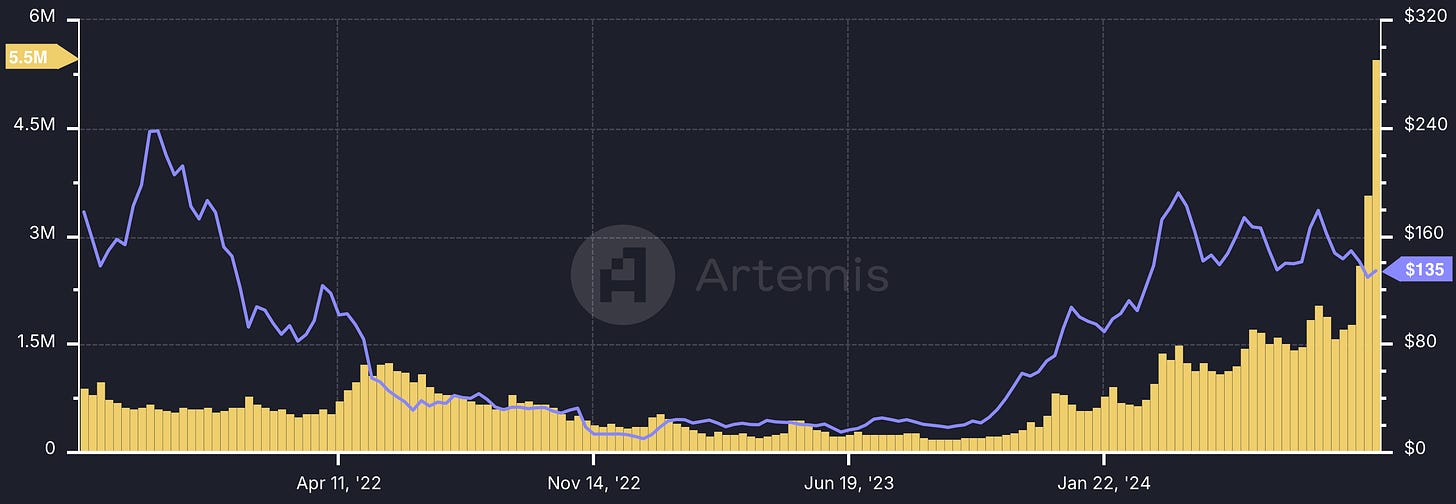
Purple line - SOL price; Yellow line - SOL daily active addresses (5.5 million - the highest in history)
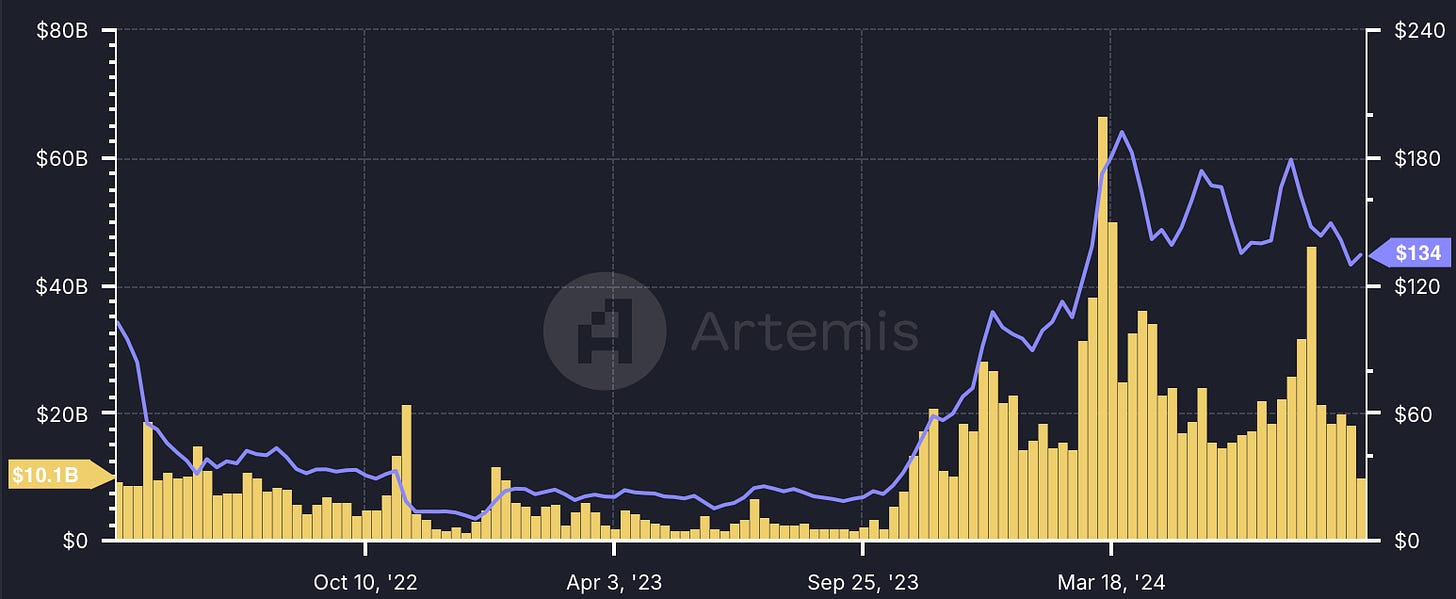
Purple line - SOL price; Yellow line - SOL daily trading volume

Solana - Financial Statements (Source: tokenterminal )

Top 5 Solana Validators (Note: all values are in SOL; data includes all staked tokens, not just actively staked tokens)
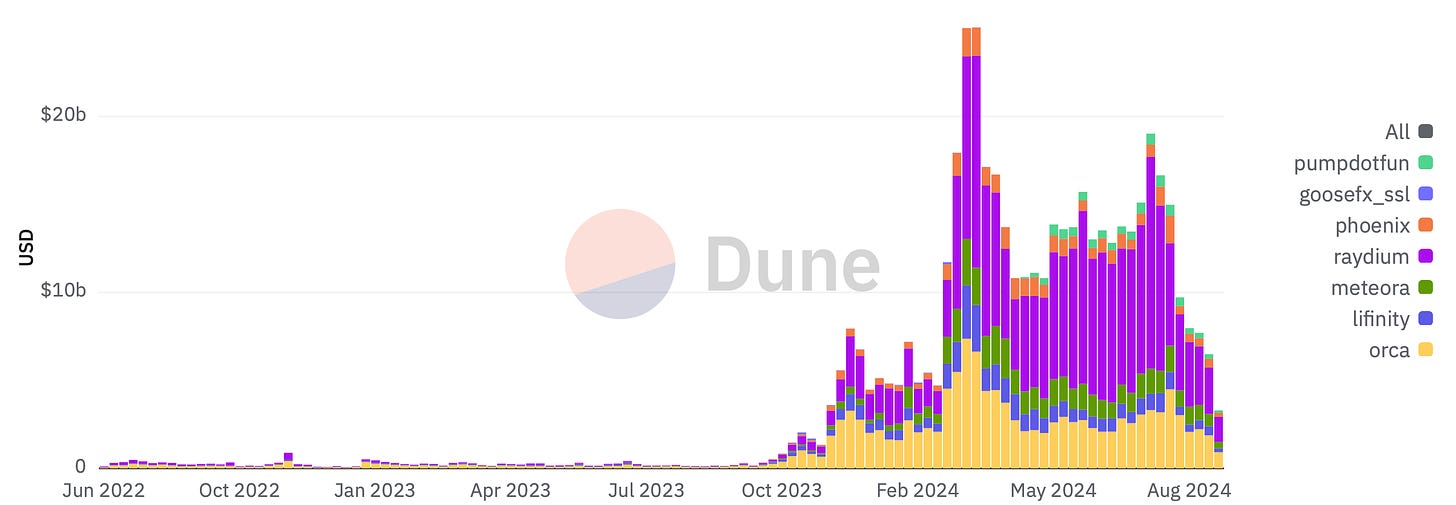
Solana DEX Volume (USD)

Solana DEX Statistics

Jito Validator Rewards








